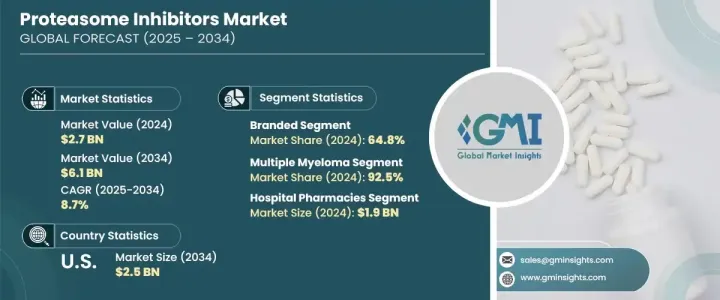
|
시장보고서
상품코드
1708204
프로테아좀 저해제 시장 기회, 성장 촉진요인, 산업 동향 분석, 예측(2025-2034년)Proteasome Inhibitors Market Opportunity, Growth Drivers, Industry Trend Analysis, and Forecast 2025 - 2034 |
||||||
세계의 프로테아좀 저해제 시장은 2024년에 27억 달러로 평가되며, 2025-2034년에 CAGR 8.7%로 확대할 것으로 예측됩니다.
세포독성 약물의 일종인 프로테아좀 억제제는 프로테아좀의 키모트립신 유사 효소 활성을 억제하여 세포내 단백질 분해를 억제하여 강력한 항암 작용을 나타냅니다. 현재 이 억제제는 주로 다발성골수종, 맨틀세포 림프종 등의 치료에 사용되고 있습니다. 현재 진행 중인 임상시험은 임상 적용 범위를 넓히는 것을 목표로 하고 있습니다. 제약회사들은 더 높은 효능, 더 넓은 임상 적응증, 병용요법에 대한 적합성을 개선한 새로운 프로테아좀 억제제를 도입하기 위해 연구개발에 대한 투자를 늘리고 있습니다. 치료 결과 개선과 약물 내성 대응에 대한 관심이 높아지면서 이 시장의 기술 혁신이 촉진되고 있습니다.

시장은 약물의 유형에 따라 브랜드 의약품과 제네릭 의약품으로 구분됩니다. 다발성골수종 관리를 위한 표적치료제의 채택이 증가함에 따라 2024년에는 프로테아좀 억제제 브랜드 의약품이 전체 시장 점유율의 64.8%를 차지할 것으로 예측됩니다. 전 세계에서 다발성골수종 발병률이 증가함에 따라 효능이 입증되고 환자 예후가 우수한 브랜드 의약품에 대한 수요가 증가하고 있습니다. 브랜드 치료제는 높은 표적 친화성을 가지고 프로테아좀 활성을 효과적으로 억제하여 질병을 더 잘 관리할 수 있습니다. 프로테아좀 억제제와 면역조절제, 부신피질 스테로이드제 등의 병용요법이 증가하고 있는 것도 이 분야의 성장을 더욱 가속화하고 있습니다.
| 시장 범위 | |
|---|---|
| 시작연도 | 2024년 |
| 예측연도 | 2025-2034년 |
| 시작 금액 | 27억 달러 |
| 예상 금액 | 61억 달러 |
| CAGR | 8.7% |
용도별로 프로테아좀 억제제 시장은 다발성골수종과 맨틀세포 림프종으로 나뉩니다. 다발성골수종 치료는 신규 진단 건수 증가와 조기 발견 및 치료에 대한 인식 증가로 인해 2024년 시장 점유율 92.5%를 차지할 것으로 예측됩니다. 다발성골수종 유병률이 증가함에 따라 환자와 의료진은 프로테아좀 억제제를 포함한 보다 표적화된 치료 옵션에 대한 요구가 증가하고 있습니다. 혁신적인 치료법과 향상된 진단 기술에 대한 접근성이 높아지면서 프로테아좀 억제제 치료를 받을 수 있는 환자 수가 크게 늘어났습니다.
유통 채널에는 병원 약국, 소매 약국, E-Commerce가 포함됩니다. 병원 약국은 2024년 19억 달러의 매출을 기록할 것으로 예상되며, 유통 상황을 지배하고 있습니다. 프로테아좀 억제제는 일반적으로 피하 또는 정맥 주사로 투여되므로 병원에서는 전문적인 치료가 필요합니다. 병원은 복잡한 치료를 관리하고 잠재적인 부작용을 모니터링 할 수있는 시설이 잘 갖추어져 있으므로 병원 약국에서 이러한 약물의 조달을 촉진합니다. 또한 대형 보험사들은 병원에서의 구매에 대해 더 유리한 상환율을 제공함으로써 이 부문의 우위를 더욱 강화하고 있습니다.
북미의 프로테아좀 억제제 시장은 2024년 11억 달러에서 2034년 25억 달러로 크게 성장할 것으로 예측됩니다. 다발성골수종의 높은 유병률과 스크리닝 및 진단 기술의 발전이 시장 성장의 원동력이 되고 있습니다. 신규 프로테아좀 억제제 개발에 주력하는 주요 바이오텍 및 제약사들의 존재는 이 지역 시장 확대에 크게 기여하고 있습니다. 새로운 치료용도 발굴을 위한 연구 노력이 계속되고 있으며, 예측 기간 중 시장은 강력한 성장세를 보일 것으로 예측됩니다.
목차
제1장 조사 방법과 조사 범위
제2장 개요
제3장 업계 인사이트
- 에코시스템 분석
- 업계에 대한 영향요인
- 촉진요인
- 다발성골수종 및 관련 암의 유병률 상승
- 의약품 개발과 승인의 진전
- 종양학 연구에 대한 투자의 증가
- 신흥 시장에서의 사업 확대
- 업계의 잠재적 리스크 & 과제
- 높은 치료비
- 부작용과 약제 내성
- 촉진요인
- 성장 가능성 분석
- 규제 상황
- 갭 분석
- 특허 분석
- 파이프라인 분석
- Porter의 산업 분석
- PESTEL 분석
제4장 경쟁 구도
- 서론
- 기업 점유율 분석
- 기업 매트릭스 분석
- 주요 시장 기업의 경쟁 분석
- 경쟁 포지셔닝 매트릭스
- 전략 대시보드
제5장 시장 추산·예측 : 약제 유형별, 2021-2034년
- 주요 동향
- 브랜드
- Velcade(bortezomib)
- Kyprolis(carfilzomib)
- Ninlaro(Ixazomib)
- 제네릭
제6장 시장 추산·예측 : 용도별, 2021-2034년
- 주요 동향
- 다발성골수종
- 맨틀 세포 림프종
제7장 시장 추산·예측 : 유통 채널별, 2021-2034년
- 주요 동향
- 병원 약국
- 소매 약국
- E-Commerce
제8장 시장 추산·예측 : 지역별, 2021-2034년
- 주요 동향
- 북미
- 미국
- 캐나다
- 유럽
- 독일
- 영국
- 프랑스
- 스페인
- 이탈리아
- 네덜란드
- 아시아태평양
- 중국
- 일본
- 인도
- 호주
- 한국
- 라틴아메리카
- 브라질
- 멕시코
- 아르헨티나
- 중동 및 아프리카
- 남아프리카공화국
- 사우디아라비아
- 아랍에미리트
제9장 기업 개요
- Amgen
- Apotex
- Aurobindo Pharma
- Baxter International
- Bristol Myers Squibb
- Camber Pharmaceuticals
- Dr. Reddy's Laboratories
- Eugia US
- Fresenius Kabi
- Gland Pharma
- Johnson &Johnson
- QLi5 Therapeutics
- Sagent Pharmaceuticals
- Selleck Chemicals
- Takeda Pharmaceutical Company
- Zydus
The Global Proteasome Inhibitors Market was valued at USD 2.7 billion in 2024 and is projected to expand at a CAGR of 8.7% from 2025 to 2034. Proteasome inhibitors, a class of cytotoxic medications, block the chymotrypsin-like enzymatic activity of the proteasome, disrupting protein degradation within cells and exhibiting strong anticancer potential. Currently, these inhibitors are primarily used in oncology to treat conditions such as multiple myeloma and mantle cell lymphoma. Ongoing clinical trials aim to broaden the scope of their clinical applications. Pharmaceutical companies are increasing investments in research and development to introduce new proteasome inhibitors with higher efficacy, broader clinical indications, and improved compatibility for combination therapies. The growing focus on enhancing treatment outcomes and addressing drug resistance is driving innovation in this market.

The market is segmented by drug type into branded and generic categories. Branded proteasome inhibitors accounted for 64.8% of the total market share in 2024, driven by the rising adoption of targeted therapies to manage multiple myeloma. Increased incidence of multiple myeloma globally is boosting demand for branded medications with proven efficacy and superior patient outcomes. Branded therapies exhibit higher target affinity, enabling effective inhibition of proteasome activity and better disease control. The growing use of combination therapies, such as combining proteasome inhibitors with immunomodulatory agents and corticosteroids, is further accelerating segment growth.
| Market Scope | |
|---|---|
| Start Year | 2024 |
| Forecast Year | 2025-2034 |
| Start Value | $2.7 Billion |
| Forecast Value | $6.1 Billion |
| CAGR | 8.7% |
By application, the proteasome inhibitors market is divided into multiple myeloma and mantle cell lymphoma. Multiple myeloma therapies accounted for 92.5% of the market share in 2024, primarily due to a rising number of newly diagnosed cases and increased awareness about early detection and treatment. The growing prevalence of multiple myeloma is prompting patients and healthcare providers to seek more targeted treatment options, which include proteasome inhibitors. Increased access to innovative therapies and improved diagnostic technologies has significantly expanded the patient pool eligible for treatment with proteasome inhibitors.
The distribution channel segmentation includes hospital pharmacies, retail pharmacies, and e-commerce. Hospital pharmacies generated USD 1.9 billion in revenue in 2024, dominating the distribution landscape. Proteasome inhibitors are typically administered via subcutaneous or intravenous routes, requiring specialized care in hospital settings. Hospitals are well-equipped to manage complex therapies and monitor potential side effects, which encourages higher procurement of these medications from hospital pharmacies. Additionally, major insurance providers offer more favorable reimbursement rates for hospital-based purchases, further strengthening the dominance of this segment.
In North America, the US proteasome inhibitors market is expected to grow substantially, increasing from USD 1.1 billion in 2024 to USD 2.5 billion by 2034. High incidence rates of multiple myeloma, along with advancements in screening and diagnostic technologies, are driving market growth. The presence of leading biotechnology and pharmaceutical companies focused on developing novel proteasome inhibitors is contributing significantly to regional market expansion. As research efforts continue to unlock new therapeutic applications, the market is set to witness strong growth through the forecast period.
Table of Contents
Chapter 1 Methodology and Scope
- 1.1 Market scope and definitions
- 1.2 Research design
- 1.2.1 Research approach
- 1.2.2 Data collection methods
- 1.3 Base estimates and calculations
- 1.3.1 Base year calculation
- 1.3.2 Key trends for market estimation
- 1.4 Forecast model
- 1.5 Primary research and validation
- 1.5.1 Primary sources
- 1.5.2 Data mining sources
Chapter 2 Executive Summary
- 2.1 Industry 3600 synopsis
Chapter 3 Industry Insights
- 3.1 Industry ecosystem analysis
- 3.2 Industry impact forces
- 3.2.1 Growth drivers
- 3.2.1.1 Rising prevalence of multiple myeloma and related cancers
- 3.2.1.2 Advancements in drug development and approvals
- 3.2.1.3 Growing investments in oncology research
- 3.2.1.4 Expansion in emerging markets
- 3.2.2 Industry pitfalls and challenges
- 3.2.2.1 High treatment costs
- 3.2.2.2 Adverse side effects and drug resistance
- 3.2.1 Growth drivers
- 3.3 Growth potential analysis
- 3.4 Regulatory landscape
- 3.5 Gap analysis
- 3.6 Patent analysis
- 3.7 Pipeline analysis
- 3.8 Porter's analysis
- 3.9 PESTEL analysis
Chapter 4 Competitive Landscape, 2024
- 4.1 Introduction
- 4.2 Company market share analysis
- 4.3 Company matrix analysis
- 4.4 Competitive analysis of major market players
- 4.5 Competitive positioning matrix
- 4.6 Strategy dashboard
Chapter 5 Market Estimates and Forecast, By Drug Type, 2021 – 2034 ($ Mn)
- 5.1 Key trends
- 5.2 Branded
- 5.2.1 Velcade (bortezomib)
- 5.2.2 Kyprolis (carfilzomib)
- 5.2.3 Ninlaro (Ixazomib)
- 5.3 Generic
Chapter 6 Market Estimates and Forecast, By Application, 2021 – 2034 ($ Mn)
- 6.1 Key trends
- 6.2 Multiple myeloma
- 6.3 Mantle cell lymphoma
Chapter 7 Market Estimates and Forecast, By Distribution Channel, 2021 – 2034 ($ Mn)
- 7.1 Key trends
- 7.2 Hospital pharmacies
- 7.3 Retail pharmacies
- 7.4 E-commerce
Chapter 8 Market Estimates and Forecast, By Region, 2021 – 2034 ($ Mn)
- 8.1 Key trends
- 8.2 North America
- 8.2.1 U.S.
- 8.2.2 Canada
- 8.3 Europe
- 8.3.1 Germany
- 8.3.2 UK
- 8.3.3 France
- 8.3.4 Spain
- 8.3.5 Italy
- 8.3.6 Netherlands
- 8.4 Asia Pacific
- 8.4.1 China
- 8.4.2 Japan
- 8.4.3 India
- 8.4.4 Australia
- 8.4.5 South Korea
- 8.5 Latin America
- 8.5.1 Brazil
- 8.5.2 Mexico
- 8.5.3 Argentina
- 8.6 Middle East and Africa
- 8.6.1 South Africa
- 8.6.2 Saudi Arabia
- 8.6.3 UAE
Chapter 9 Company Profiles
- 9.1 Amgen
- 9.2 Apotex
- 9.3 Aurobindo Pharma
- 9.4 Baxter International
- 9.5 Bristol Myers Squibb
- 9.6 Camber Pharmaceuticals
- 9.7 Dr. Reddy's Laboratories
- 9.8 Eugia US
- 9.9 Fresenius Kabi
- 9.10 Gland Pharma
- 9.11 Johnson & Johnson
- 9.12 QLi5 Therapeutics
- 9.13 Sagent Pharmaceuticals
- 9.14 Selleck Chemicals
- 9.15 Takeda Pharmaceutical Company
- 9.16 Zydus



















